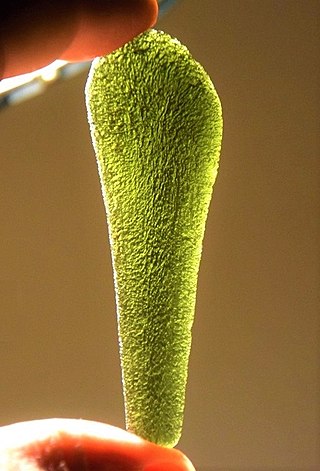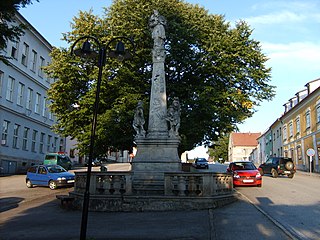
Vltava is the longest river in the Czech Republic, running southeast along the Bohemian Forest and then north across Bohemia, through Český Krumlov, České Budějovice and Prague, and finally merging with the Labe at Mělník. It is commonly referred to as the "Czech national river".

The Drottningholm Palace Theatre is an opera house located at Drottningholm Palace in Stockholm, Sweden. It is one of the few 18th century theatres in Europe that is still used as a theatre with its original stage machinery.

A theater, theatre or playhouse, is a structure where theatrical works, performing arts and musical concerts are presented. The theater building serves to define the performance and audience spaces. The facility usually is organized to provide support areas for performers, the technical crew and the audience members, as well as the stage where the performance takes place.
A revolving stage is a mechanically controlled platform within a theatre that can be rotated in order to speed up the changing of a scene within a show. A fully revolving set was an innovation constructed by the hydraulics engineer Tommaso Francini for an elaborately produced pageant, Le ballet de la délivrance de Renaud, which was presented for Marie de Medici in January 1617 at the Palais du Louvre and noted with admiration by contemporaries. Such a stage is also commonly referred to as a turntable.

Týn nad Vltavou is a town in České Budějovice District in the South Bohemian Region of the Czech Republic. It has about 7,800 inhabitants. It lies on the Vltava river. The town centre is well preserved and is protected by law as an urban monument zone.

Kralupy nad Vltavou is a town in Mělník District in the Central Bohemian Region of the Czech Republic. It has about 18,000 inhabitants. It is known as a traffic hub and industrial agglomeration. The town is a part of the Prague metropolitan area.

Moldavite is a forest green, olive green or blue greenish vitreous silica projectile glass formed by a meteorite impact in southern Germany that occurred about 15 million years ago. It is a type of tektite.

Vyšší Brod is a town in Český Krumlov District in the South Bohemian Region of the Czech Republic. It has about 2,500 inhabitants. It is the southernmost municipality in the Czech Republic. Vyšší Brod Monastery, an important historic landmark, is located in the town. The historic town centre with the monastery complex is well preserved and is protected by law as an urban monument zone.

Pyynikki Summer Theatre is an open-air theatre operating in Tampere, Finland, known especially for its revolving auditorium. It is one of the largest summer theatres in Finland and has been running uninterrupted longer than any other open-air theatre in the country.

The Lipno Reservoir is a dam and hydroelectric plant constructed along the Vltava River in the Czech Republic. It is the largest water area in the Czech Republic.

Lipno nad Vltavou is a municipality and village in Český Krumlov District in the South Bohemian Region of the Czech Republic. It has about 600 inhabitants. It is a popular summer resort.

Český Krumlov is a town in the South Bohemian Region of the Czech Republic. It has about 12,000 inhabitants. It is known as a tourist centre, which is among the most visited places in the country. The historic centre with the Český Krumlov Castle complex is protected by law as an urban monument reservation, and since 1992, it has been a designated UNESCO World Heritage Site because of its well-preserved Gothic, Renaissance and Baroque architecture.

Benešov nad Černou is a municipality and village in Český Krumlov District in the South Bohemian Region of the Czech Republic. It has about 1,400 inhabitants. The centre of Benešov nad Černou is well preserved and is protected by law as an urban monument zone.

Český Krumlov Castle is a castle in Český Krumlov in the South Bohemian Region of the Czech Republic. It dates back to 1240 when the first castle was built by the Vítkovci family, the main branch of the powerful Bohemian family Rosenberg.

Emila Medková, née Emila Tláskalová was a Czech photographer, one of the important exponents of the Czech art photography in the second half of the 20th century. Her work was influenced by Surrealism. She was the wife of painter Mikuláš Medek.

EuroVelo 7 (EV7), named the Sun Route, is a 7,409 km (4,604 mi) long EuroVelo long-distance cycling route running north–south through the whole of Europe from the North Cape in Norway to the island of Malta in the Mediterranean Sea. The route passes through nine countries, and from north to south these are: Norway, Finland, Sweden, Denmark, Germany, Czech Republic, Austria, Italy, Malta.
The European Route of Historic Theatres is a holiday route and European Cultural Route, that runs through many European countries. It links cities with important historic theatres from the 16th to 19th centuries.
The 4th Army was a field army of the Czechoslovak People's Army, active from 1958 to 1965 and 1969–1991. In its second formation its headquarters was in Pisek.

Pietà from Všeměřice is a representational work of medieval art from the late Beautiful style period preserved in the Czech territory. It is on display in the permanent exhibition of the Aleš South Bohemian Gallery in Hluboká nad Vltavou.

The Franciscan Madonna is a monumental carving of the late beautiful style, which is compositionally related to the Pilsen Madonna. In some details, it resembles works from the circle of the Master of Týn Calvary. The statue comes from the main altar of the Church of the Assumption of the Virgin Mary of the Franciscan Monastery in Pilsen and is on display in the exposition of medieval art of the National Gallery in Prague.

















